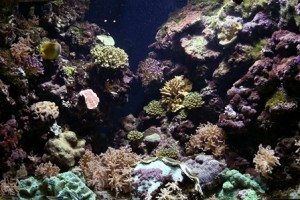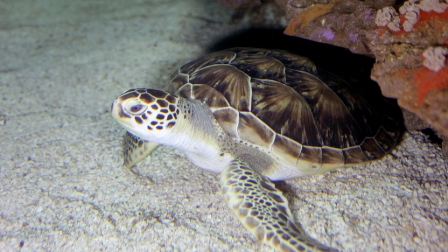Climate and Coral
An important habitat for many ocean animals, including sea turtles, is coral reef ecosystems. Coral reefs provide a home for animals to take shelter and hide in, and provide many places for animals to find food. Changes in the ocean are causing these sensitive habitats to weaken. Future generations and ocean animals depend on us to protect these habitats. We can make a difference by focusing on ways to help solve this problem before it gets worse.

Live coral in the NC Aquarium at Fort Fisher’s Pacific Reef Exhibit that was propagated on-site instead of taken from the ocean
Every time we turn on a light in a room, we are using electricity that is made by burning fossil fuels (coal, oil or natural gas). This is how we run our everyday lives. When we burn fossil fuels, carbon dioxide is released into the atmosphere. Some of this is absorbed by the ocean like a sponge, which changes the ocean water chemistry. As a result, we are seeing “osteoporosis of the sea,” with sea creatures’ skeletons and shells becoming thinner or more brittle. Just like we need calcium to build strong bones and have healthy bodies, sea creatures like corals and sponges, need something similar called calcium carbonate to build their skeletons and shells. The corals and sponges are unable to pull the calcium carbonate from the sea water because of the chemistry changes. Without being able to do this, their structures become brittle and weak. This affects all of the animals who use these places to find food and seek shelter in.
Sea turtles in particular rely on coral reefs to find food. The vegetable-loving green sea turtle tears seagrasses and scrapes algae off of hard surfaces, like coral. Other sea turtles like loggerheads and Kemp’s ridleys use their powerful crushing jaws to eat hard-shelled animals like whelks and crabs living among the reefs. Hawksbills specialize in eating sponges with their hawk-like beak; sponges also help make up the hard structures of reefs. If we want to ensure sea turtles have these important habitats to find food and seek shelter in, it is essential we protect the oceans and the coral reefs in them.
Luckily, there are many simple and easy things we can do to help decrease our fossil fuel use here on land to help the sea turtles in the oceans. Some easy actions are:
- Carpool with a friend if you are going to the same place or start a carpool to school with your friends that live in the same neighborhood as you.
- Participate in a Bike to School Day or organize one for your community.
- Turn off the lights in your classroom or TV in your family’s house if you are not using it.
These are not only great things that you can do, but a group of your friends can do them together. Can you think of any other ways to get your community to take action?
Learn about how climate could also affect sea turtle gender in our Ladies and Gentleman, Boys and Girls lesson plan. And of course, use this week’s updated hatchling measurements for our Hatchling to Yearling lesson plan. Turtle A now weighs 1006 grams and measures 18.6 cm long and Turtle B weighs 913 grams and now measures 17.6 cm long.









